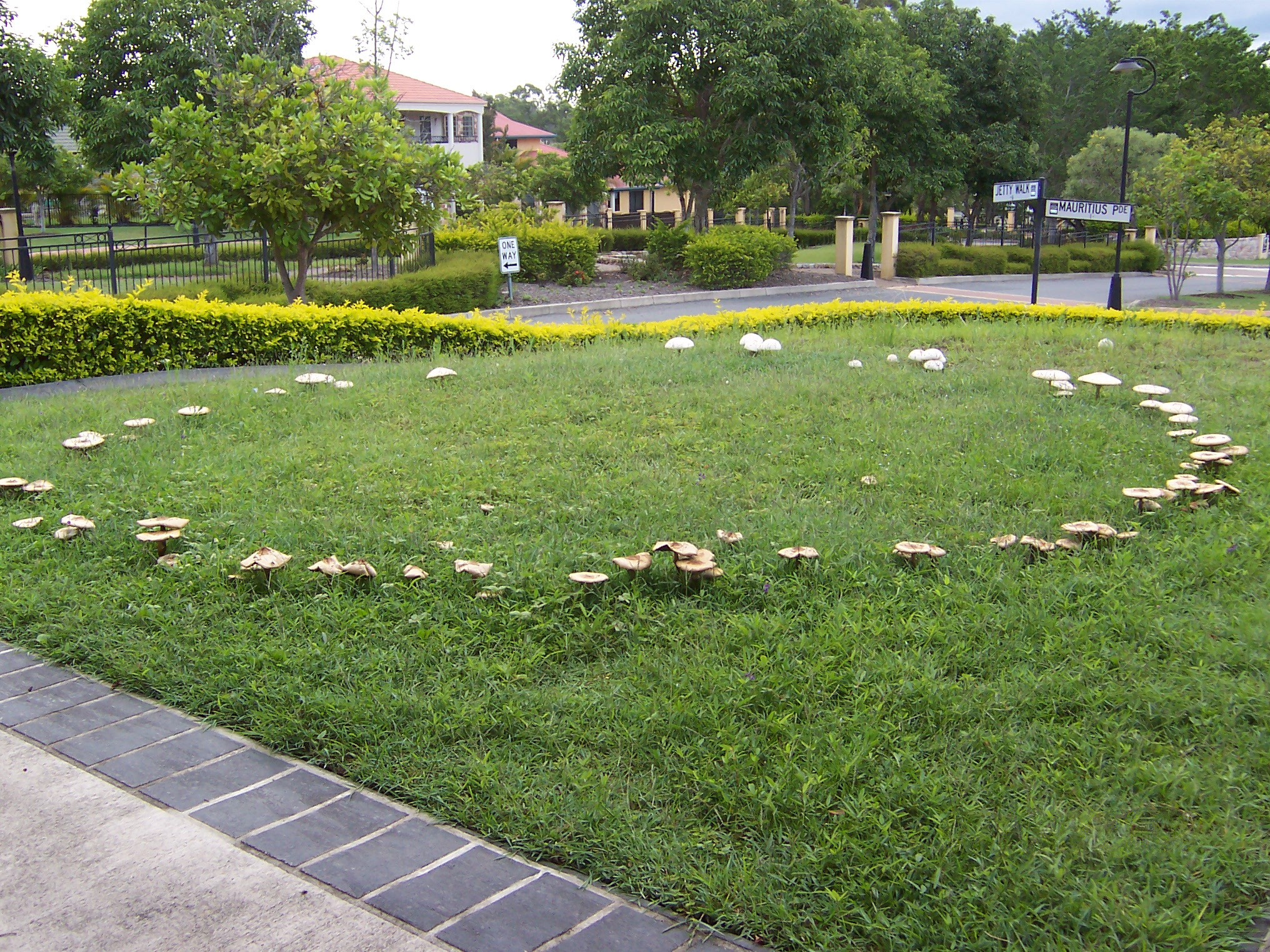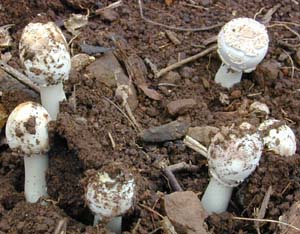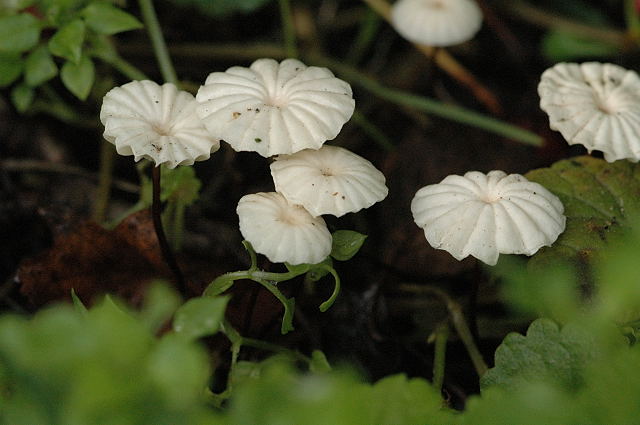|
Marasmius Vagus
''Marasmius vagus'', the wandering creamsicle or wandering parachute, is a small bright orange gilled mushroom in the family Marasmiaceae. Etymology The Greek language word ''marasmos'' means "drying out" and was applied to this genus because some members have an ability to dry out and then revive with moisture. Members of the genus produce white spores and have a central stipe (stem or stalk) that is often tough or wiry. ''Vagus'' refers to their geographical spreading as with a vagabond or vagrant. Description The orange cap is wide. The white Lamella (mycology), gills are adnexed. The stem is usually not centered or straight, growing up to long and thick. Both the flesh and spore print are white. Distribution and habitat Native to northern Australia, they commonly grow in lawns in Florida where the brightly colored mushrooms are found growing in clusters and partial fairy rings. Cautions It is not believed to be toxic but it resembles some poisonous mushrooms. Ref ... [...More Info...] [...Related Items...] OR: [Wikipedia] [Google] [Baidu] |
Marasmiaceae
The Marasmiaceae are a family (biology), family of fungi in the order (biology), order Agaricales. Basidiocarps (fruit bodies) are most frequently agarics (gilled mushrooms), but occasionally cyphelloid (in the genus ''Cellypha''). According to a 2008 estimate, the family contained 54 genera and 1590 species, but Molecular phylogenetics, molecular research, based on cladistic analysis of DNA sequences, has led to a more restricted family concept, so that the Marasmiaceae included just 13 genera, and some 1205 species. It was reduced further down in 2020, to 10 genera and about 700 species. Genera As accepted by Wijayawardene et al. 2020; *''Amyloflagellula'' (4) *''Brunneocorticium'' (1) *''Campanella (fungus), Campanella'' (ca. 39) *''Chaetocalathus'' (ca. 20) *''Crinipellis'' (ca. 65) *''Hymenogloea'' (1) *''Marasmius'' (ca. 600) *''Moniliophthora'' (7) *''Neocampanella'' (1) *''Tetrapyrgos'' (18) See also *List of Agaricales families References * ... [...More Info...] [...Related Items...] OR: [Wikipedia] [Google] [Baidu] |
Lamella (mycology)
In mycology, a lamella (: lamellae), or gill, is a papery hymenophore rib under the cap of some mushroom species, most often agarics. The gills are used by the mushrooms as a means of spore dispersal, and are important for species identification. The attachment of the gills to the stem is classified based on the shape of the gills when viewed from the side, while color, crowding and the shape of individual gills can also be important features. Additionally, gills can have distinctive microscopic or macroscopic features. For instance, ''Lactarius'' species typically seep latex from their gills. It was originally believed that all gilled fungi were Agaricales, but as fungi were studied in more detail, some gilled species were demonstrated not to be. It is now clear that this is a case of convergent evolution (i.e. gill-like structures evolved separately) rather than being an anatomic feature that evolved only once. The apparent reason that various basidiomycetes have evolv ... [...More Info...] [...Related Items...] OR: [Wikipedia] [Google] [Baidu] |
Audubon
The National Audubon Society (Audubon; ) is an American non-profit environmental organization dedicated to conservation of birds and their habitats. Located in the United States and incorporated in 1905, Audubon is one of the oldest of such organizations in the world. There are completely independent Audubon Societies in the United States, which were founded several years earlier such as the Massachusetts Audubon Society, Indiana Audubon Society, and Connecticut Audubon Society. The societies are named for 19th century naturalist John James Audubon. The society has nearly 500 local chapters, each of which is an independent 501(c)(3) non-profit organization voluntarily affiliated with the National Audubon Society. They often organize birdwatching field trips and conservation-related activities. It also coordinates the Christmas Bird Count held each December in the U.S., a model of citizen science, in partnership with Cornell Lab of Ornithology, and the Great Backyard Bird Co ... [...More Info...] [...Related Items...] OR: [Wikipedia] [Google] [Baidu] |
Knopf
Alfred A. Knopf, Inc. () is an American publishing house that was founded by Blanche Knopf and Alfred A. Knopf Sr. in 1915. Blanche and Alfred traveled abroad regularly and were known for publishing European, Asian, and Latin American writers in addition to leading American literary trends. It was acquired by Random House in 1960, and is now part of the Knopf Doubleday Publishing Group division of Penguin Random House which is owned by the German conglomerate Bertelsmann. The Knopf publishing house is associated with the borzoi logo in its colophon (publishing), colophon, which was designed by co-founder Blanche Knopf in 1925. History Founding Knopf was founded in 1915 by Alfred A. Knopf Sr. along with Blanche Knopf, on a $5,000 advance from his father, Samuel Knopf. The first office was located in New York's Candler Building (New York City), Candler Building. The publishing house was officially incorporated in 1918, with Alfred Knopf as president, Blanche Knopf as vice pres ... [...More Info...] [...Related Items...] OR: [Wikipedia] [Google] [Baidu] |
Spore Print
300px, Making a spore print of the mushroom ''Volvariella volvacea'' shown in composite: (photo lower half) mushroom cap laid on white and dark paper; (photo upper half) cap removed after 24 hours showing warm orange ("tussock") color spore print. A 3.5-centimeter glass slide placed in middle allows for examination of spore characteristics under a microscope. The spore print is the powdery deposit obtained by allowing spores of a fungal fruit body to fall onto a surface underneath. It is an important diagnostic character in most handbooks for identifying mushrooms. It shows the colour of the mushroom spores if viewed en masse. Method A spore print is made by placing the spore-producing surface flat on a sheet of dark and white paper or on a sheet of clear, stiff plastic, which facilitates moving the spore print to a darker or lighter surface for improved contrast; for example, it is easier to determine whether the spore print is pure white or, rather, very slightly pigmented. ... [...More Info...] [...Related Items...] OR: [Wikipedia] [Google] [Baidu] |
Fairy Ring
A fairy ring, also known as fairy circle, elf circle, elf ring or pixie ring, is a naturally occurring ring or arc of mushrooms. They are found mainly in forested areas, but also appear in grasslands or rangelands. Fairy rings are detectable by sporocarps (fungal spore pods) in rings or arcs, as well as by a necrotic zone (dead grass), or a ring of dark green grass. Fungus mycelium is present in the ring or arc underneath. The rings may grow to over in diameter, and they become stable over time as the fungus grows and seeks food underground. Fairy rings are the subject of much folklore and myth worldwide, particularly in Western Europe. They are alternately seen as hazardous or dangerous places linked with witches or the Devil, or as a sign of good fortune. Genesis The mycelium of a fungus growing in the ground absorbs nutrients by secretion of enzymes from the tips of the hyphae (thread-like branching filaments making up the mycelium). This breaks down larger molecules in th ... [...More Info...] [...Related Items...] OR: [Wikipedia] [Google] [Baidu] |
Poisonous Mushrooms
Mushroom poisoning is poisoning resulting from the ingestion of mushrooms that contain toxic substances. Symptoms can vary from slight gastrointestinal discomfort to death in about 10 days. Mushroom toxins are secondary metabolites produced by the fungus. Mushroom poisoning is usually the result of ingestion of wild mushrooms after misidentification of a toxic mushroom as an edible species. The most common reason for this misidentification is a close resemblance in terms of color and general morphology of the toxic mushrooms species with edible species. To prevent mushroom poisoning, mushroom gatherers familiarize themselves with the mushrooms they intend to collect, as well as with any similar-looking toxic species. The safety of eating wild mushrooms may depend on methods of preparation for cooking. Some toxins, such as amatoxins, are thermostable and mushrooms containing such toxins will not be rendered safe to eat by cooking. Signs and symptoms Poisonous mushrooms contain a ... [...More Info...] [...Related Items...] OR: [Wikipedia] [Google] [Baidu] |
Marasmius
''Marasmius'' is a genus of mushroom-forming fungi in the family Marasmiaceae. It contains about 500 species of agarics, of which a few, such as '' Marasmius oreades'', are edible. However, most members of this genus are small, unimpressive brown mushrooms. Their humble appearance contributes to their not being readily distinguishable to non-specialists, and they are therefore seldom collected by mushroom hunters. Several of the species are known to grow in the characteristic fairy ring pattern. The author of the genus was Elias Magnus Fries, who in 1838 classified white-spored agarics having a tough central stipe in this taxon if they were marcescent, i.e. they could dry out but later revive when moistened. For Fries, marcescence—by contrast with the " putrescent" (decomposing) nature of most mushrooms—was an important character for classification, which he used to separate this group from genus '' Collybia'' (which has now been split into many newer gener ... [...More Info...] [...Related Items...] OR: [Wikipedia] [Google] [Baidu] |
Fungi Native To Australia
A fungus (: fungi , , , or ; or funguses) is any member of the group of eukaryotic organisms that includes microorganisms such as yeasts and molds, as well as the more familiar mushrooms. These organisms are classified as one of the traditional eukaryotic kingdoms, along with Animalia, Plantae, and either Protista or Protozoa and Chromista. A characteristic that places fungi in a different kingdom from plants, bacteria, and some protists is chitin in their cell walls. Fungi, like animals, are heterotrophs; they acquire their food by absorbing dissolved molecules, typically by secreting digestive enzymes into their environment. Fungi do not photosynthesize. Growth is their means of mobility, except for spores (a few of which are flagellated), which may travel through the air or water. Fungi are the principal decomposers in ecological systems. These and other differences place fungi in a single group of related organisms, named the ''Eumycota'' (''true fungi'' or ''Eumycet ... [...More Info...] [...Related Items...] OR: [Wikipedia] [Google] [Baidu] |
Fungi Described In 2020
A fungus (: fungi , , , or ; or funguses) is any member of the group of eukaryotic organisms that includes microorganisms such as yeasts and mold (fungus), molds, as well as the more familiar mushrooms. These organisms are classified as one of the kingdom (biology)#Six kingdoms (1998), traditional eukaryotic kingdoms, along with Animalia, Plantae, and either Protista or Protozoa and Chromista. A characteristic that places fungi in a different kingdom from plants, bacteria, and some protists is chitin in their cell walls. Fungi, like animals, are heterotrophs; they acquire their food by absorbing dissolved molecules, typically by secreting digestive enzymes into their environment. Fungi do not photosynthesize. Growth is their means of motility, mobility, except for spores (a few of which are flagellated), which may travel through the air or water. Fungi are the principal decomposers in ecological systems. These and other differences place fungi in a single group of related o ... [...More Info...] [...Related Items...] OR: [Wikipedia] [Google] [Baidu] |







